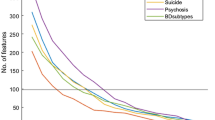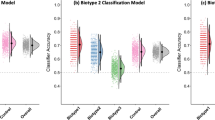Abstract
Diagnosis of patients with bipolar disorder may be challenging and delayed in clinical practice. Neuropsychological impairments and brain abnormalities are commonly reported in bipolar disorder (BD); therefore, they can serve as potential biomarkers of the disorder. Rather than relying on these predictors separately, using both structural and neuropsychiatric indicators together could be more informative and increase the accuracy of the automatic disorder classification. Yet, to our information, no Artificial Intelligence (AI) study has used multimodal data using both neuropsychiatric tests and structural brain changes to classify BD. In this study, we first investigated differences in gray matter volumes between patients with bipolar I disorder (n = 37) and healthy controls (n = 27). The results of the verbal and non-verbal memory tests were then compared between the two groups. Finally, we used the artificial neural network (ANN) method to model all the aforementioned values for group classification. Our voxel-based morphometry results demonstrated differences in the left anterior parietal lobule and bilateral insula gray matter volumes, suggesting a reduction of these brain structures in BD. We also observed a decrease in both verbal and non-verbal memory scores of individuals with BD (p < 0.001). The ANN model of neuropsychiatric test scores combined with gray matter volumes has classified the bipolar group with 89.5% accuracy. Our results demonstrate that when bilateral insula volumes are used together with neuropsychological test results the patients with bipolar I disorder and controls could be differentiated with very high accuracy. The findings imply that multimodal data should be used in AI studies as it better represents the multi-componential nature of the condition, thus increasing its diagnosability.




Similar content being viewed by others
Data availability
The data analyzed in this research paper are not publicly available and can only be shared upon a reasonable request.
References
Baldessarini RJ, Tondo L, Baethge CJ, Lepri B, Bratti IM (2007) Effects of treatment latency on response to maintenance treatment in manic-depressive disorders. Bipolar Disord 9:386–393. https://doi.org/10.1111/j.1399-5618.2007.00385.x
Gong J, Wang J, Chen P, Qi Z, Luo Z, Wang J, Huang L, Wang Y (2021) Large-scale network abnormality in bipolar disorder: a multimodal meta-analysis of resting-state functional and structural magnetic resonance imaging studies. J Affect Disord 292:9–20. https://doi.org/10.1016/j.jad.2021.05.052
Karakaş S, Kafadar H, Eski R (1996) Test-retest reliability of the Turkish standardization of Wechsler memory scale-revised. Turkish J Psychol 11(38):46–52
Kurtz M, Gerraty RT (2009) A meta-analytic investigation of neurocognitive deficits in bipolar illness: profile and effects of clinical state. Neuropsychology 23(5):551–562. https://doi.org/10.1037/a0016277
Lee RS, Hermens DF, Scott J, Redoblado-Hodge MA, Naismith SL, Lagopoulos J, Griffiths KR, Porter MA, Hickie IB (2014) A meta-analysis of neuropsychological functioning in first-episode bipolar disorders. J Psychiatr Res 57:1–11. https://doi.org/10.1016/j.jpsychires.2014.06.019
Lu X, Zhong Y, Ma Z, Wu Y, Fox PT, Zhang N, Wang C (2019) Structural imaging biomarkers for bipolar disorder: meta-analyses of whole-brain voxel-based morphometry studies. Depress Anxiety 36(4):353–364. https://doi.org/10.1002/da.22866
Mugler JP III, Brookeman JR (1990) Three-dimensional magnetization-prepared rapid gradient-echo imaging (3D MP RAGE). Magn Reson Med 15:152–157. https://doi.org/10.1002/mrm.1910150117
Öktem Ö (2011) Öktem Verbal Memory Processes Test. Turkish Psychological Association, Ankara, Turkey
Samamé C, Martino DJ, Strejilevich SA (2013) A quantitative review of neurocognition in euthymic late-life bipolar disorder. Bipolar Disord 15(6):633–644. https://doi.org/10.1111/bdi.12077
Seeley WW, Menon V, Schatzberg AF, Keller J, Glover GH, Kenna H, Reiss AL, Greicius MD (2007) Dissociable intrinsic connectivity networks for salience processing and executive control. J Neurosci 27(9):2349–2356. https://doi.org/10.1523/JNEUROSCI.5587-06.2007
Selvaraj S, Arnone D, Job D, Stanfield A, Farrow TF, Nugent AC, Scherk H, Gruber O, Chen X, Sachdev PS, Dickstein DP, Malhi GS, Ha TH, Ha K, Phillips ML, McIntosh AM (2012) Grey matter differences in bipolar disorder: a meta-analysis of voxel-based morphometry studies. Bipolar Disord 14(2):135–145. https://doi.org/10.1111/j.1399-5618.2012.01000
Stratmann M, Konrad C, Kugel H et al (2014) Insular and hippocampal gray matter volume reductions in patients with major depressive disorder. PLoS ONE 9(7):e102692. https://doi.org/10.1371/journal.pone.0102692
The Diagnostic and Statistical Manual of Mental Disorders (5th ed.; DSM–5; American Psychiatric Association, 2013)
Wang Y, Zhong S, Jia Y, Zhang S, Liang X, Li Y et al (2019) Abnormal functional connectivity density in bipolar disorder during depressive and manic states. Front Psych 10:265. https://doi.org/10.3389/fpsyt.2019.00265
WECHSLER D (1987) Wechsler Memory Scale-Revised. Psychological Corporation, San Antonio, TX
Wise T, Radua J, Nortje G, Cleare AJ, Young AH, Arnone D (2016) Voxel-based meta-analytical evidence of structural disconnectivity in major depression and bipolar disorder. Biol Psychiat 79(4):293–302. https://doi.org/10.1016/j.biopsych.2015.08.005
Author information
Authors and Affiliations
Corresponding author
Additional information
Publisher's Note
Springer Nature remains neutral with regard to jurisdictional claims in published maps and institutional affiliations.
Rights and permissions
Springer Nature or its licensor (e.g. a society or other partner) holds exclusive rights to this article under a publishing agreement with the author(s) or other rightsholder(s); author self-archiving of the accepted manuscript version of this article is solely governed by the terms of such publishing agreement and applicable law.
About this article
Cite this article
Metin, B., Farhad, S., Erguzel, T. et al. Combined use of gray matter volume and neuropsychological test performance for classification of individuals with bipolar I disorder via artificial neural network method. J Neural Transm 130, 967–974 (2023). https://doi.org/10.1007/s00702-023-02649-y
Received:
Accepted:
Published:
Issue Date:
DOI: https://doi.org/10.1007/s00702-023-02649-y




